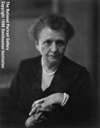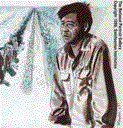

Labor Reformers
The turbulent story of the labor movement in the United States is an important one in American politics and history. Here we feature three prominent advocates for the manual worker: Frances Perkins, Samuel Gompers, and César Chávez.
 Clara E.
Sipprell (1885-1975)
Clara E.
Sipprell (1885-1975)
Photograph, gelatin silver print, 1952, NPG.77.60
National Portrait Gallery,
Smithsonian Institution, Washington, D.C.
That Frances Perkins devoted so much of her life to the plight of the American worker is noteworthy in itself. However, the fact that she also blazed a trail for women in American politics makes her accomplishments all the more extraordinary. While organizers like Samuel Gompers attempted to enact labor reform from within the labor community, Perkins attacked the same problems from the level of city, state, and finally national government.
Perkins was a pioneer in women's issues in addition to her role in labor reform. Originally born Fanny Coralie Perkins, she later changed her first name to Frances because she thought people would take her more seriously. In later life she shocked many in polite society when she refused to take her husband's name after marriage.
Perkins's interest in social reform began during her years at Mt. Holyoke College, when she joined the National Consumers League, a group organized to improve labor conditions through consumer pressure. After college she became a teacher and spent holidays working in settlement houses and other social service organizations. In 1909 she won a fellowship to study at the New York School of Philanthropy, where she met many of the city's leading reformers. In 1910 she received a master's degree in social work from Columbia University. At the same time, as head of the New York City Consumers League, she monitored workers' conditions and lobbied the state legislature on their behalf. When Perkins's acquaintance Al Smith won the New York governorship in 1918, he invited her to sit on the governing board of the state labor department. In that capacity she became known as an expert in both industrial regulation and labor-management mediation.
In 1928, Franklin D. Roosevelt, recently elected governor of New York, appointed Perkins as head of the state labor department. For a woman to assume such a post was unprecedented. It was also the beginning of a close working relationship between Roosevelt and Perkins. Four years later, after Roosevelt was elected president, he invited Perkins to serve as his secretary of labor. During their years together, Perkins was an integral part of Roosevelt's response to the Great Depression, and an advocate of social security, wage and hour regulation, and the abolition of child labor. She distanced herself from labor leaders but earned their respect as she deftly managed some of the era's most volatile labor disputes.
As Perkins rose in prominence and position, she was forced to become more acutely aware of her status as a woman. After all, at the time she joined the New York state government, women in many states were still two years away from being allowed to vote. As a consequence, she was very careful about her demeanor and appearance when interacting with her male colleagues. On the subject of dress, she once remarked: "Many good and intelligent women do dress in ways that are very attractive and pretty, but don't particularly invite confidence in their common sense, integrity or sense of justice."
By the time of Roosevelt's death in 1945, Perkins was ready to retire. However, she remained active for several more years, serving on the United States Civil Service Commission, lecturing, and writing. Her best-known book is the memoir The Roosevelt I Knew (1946). After 1957, she served as a visiting professor at Cornell University.
 Unidentified
photographer
Unidentified
photographer
Photograph, gelatin silver print, 1921, NPG.77.202
National Portrait Gallery,
Smithsonian Institution, Washington, D.C.
As the power and scale of American industry grew during the nineteenth century, working conditions for most Americans underwent radical change. Mechanized, large-scale factories staffed by unskilled laborers gradually came to replace specialized craftsmen and small workshops. Trade unions, which had been designed to serve the older system, initially failed to adapt to the new conditions. Samuel Gompers, more than any other individual, helped to modernize the unions, organize them on a national scale, and open their doors to unskilled as well as skilled workers.
Gompers began his career as a cigarmaker after quitting school at age ten. In 1863, his family moved to New York City from their native England. In the multi-ethnic cigar factories of New York, the young Gompers received an informal education on the latest social theories coming from Europe. He and others discussed the industrial changes taking place and recognized the need for an improved workers' union. Gradually, Gompers began to form a plan of action.
The first task, beginning in 1877, was to revitalize the Cigarmakers' Union. Led by Gompers, the union tightened its organization, raised dues, and articulated a clear, limited agenda. Soon other trades began to follow the cigarmakers' example. But the real accomplishment came in 1881, when Gompers helped organize what was to become the American Federation of Labor (AFL), which united the various trade unions under one roof. To minimize dissension, Gompers required that each trade be represented by only one union, and that within each union the national organization should prevail over local chapters. Gompers himself served as president of the AFL every year but one until his death in 1924.
The AFL, while not the only union organization in America, was the largest and most mainstream. Though Gompers adopted ideas from socialism and communism, he never joined any political organization himself, nor did he seek to radically alter the American economic or political system. His goals for the union were clear and limited: in his words, "more wages, more leisure, more liberty" for workers through collective action. Gompers served on many official commissions, including the Council of National Defense during World War I, and was known for his conservative stances. Indeed, his harshest criticism often came from leftist militants who saw him as too much the creature of powerful industrialists.
Gompers was an excellent speaker, and after 1881 he gave much of his time to making speeches on behalf of labor. Historians agree that his success was due largely to his power of persuasion and his ability to articulate ideas and turn them into practical goals. He also wrote several books, including an autobiography, Seventy Years of Life and Labor.
 Earl
Mayan (dates unknown)
Earl
Mayan (dates unknown)
Pencil and gouache on board, 1969, T/NPG.93.275.03
National Portrait Gallery,
Smithsonian Institution, Washington, D.C.
Life was difficult for the young César Chávez, and his childhood prepared him for a career as one of America's most prominent labor organizers and civil rights activists. Chávez was born on a small family farm near Yuma, Arizona. When his parents lost their land in the Great Depression, the Chávez family joined the growing mass of migrant workers in California. Despite frequent moves and primitive living conditions, Chávez managed to reach the seventh grade.
After serving in the navy for two years during World War II, Chávez settled in California and became active in the Community Service Organization (CSO), a support group for Latinos. From 1952 to 1962, he organized chapters, led voter registration drives, and worked with needy families. In the process, he began to see unionization as an important means for bettering the lot of California's Latino migrant farm workers. In 1962, after the CSO would not support such an effort, Chávez left the CSO to establish the National Farm Workers Association (now the United Farm Workers of America) in California's agriculturally rich central valley.
In 1965, the new union joined a strike begun by Filipino workers against grape growers in the region. The strike, which lasted five years, slowly gained the support of other workers, the public, and national leaders such as Robert F. Kennedy. Chávez's idea for a grape and wine boycott was particularly successful in winning public support and disrupting the local economy. At the strike's conclusion, twenty-three local growers had signed a contract with the field workers. For Chávez, the strike signified more than a labor dispute; it was a fight for social justice. Taking inspiration from Mahatma Gandhi and Martin Luther King, Jr., Chávez advocated nonviolent protest and strict dedication to la causa. His vision and leadership made him a hero for many, but his failure to separate community from labor issues occasionally weakened his role as a union organizer.
After 1970, conditions for migrant workers slowly improved, though the workers' way of life remained difficult. California's 1975 Agricultural Labor Relations Act, which formally granted farm workers the right to collective bargaining, represented an important milestone. Up to the end of his life, Chávez was a strong, and often controversial, voice in the constant struggle to improve the lives of farmworkers and of the entire Latino community.
The Smithsonian's National Museum of American History has several objects belonging to Chávez on display, including his jacket with a "No Grapes" button attached.
LINKS
General
Frances Perkins
Samuel Gompers
César Chávez